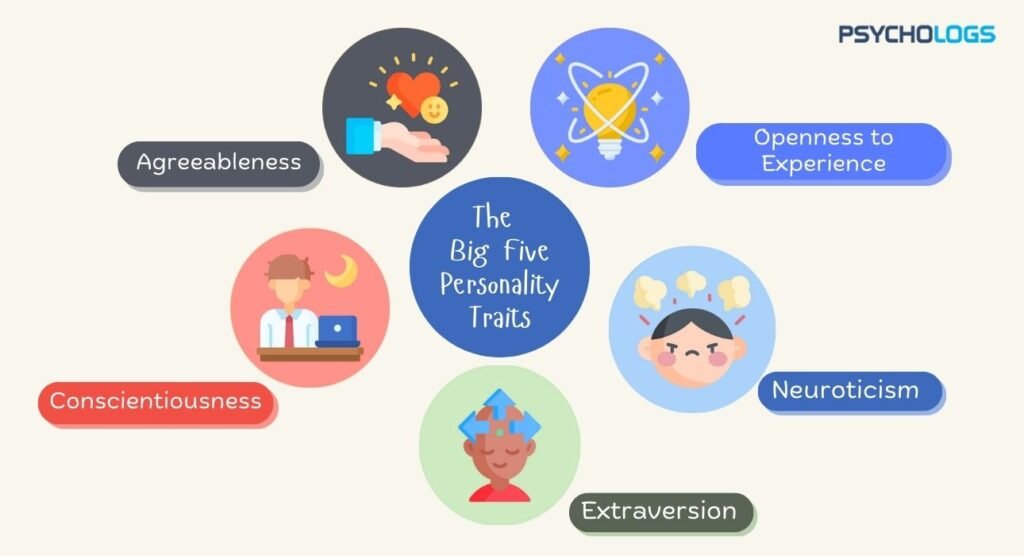The HEXACO model of personality is a dynamic framework for understanding human personality. It categorises traits into six broad dimensions: Honesty-Humility, Emotionality, Extraversion, Agreeableness, Conscientiousness, and Openness to Experience. This model, developed from psychological studies where personality traits are analysed based on ratings of descriptive adjectives, stands out for its cross-cultural validation.
Researchers Ashton, Lee, and others found that these six factors emerge consistently across different languages and populations, making the HEXACO model a reliable representation of personality structure. Each of these six dimensions represents a continuum, capturing the variability in human behaviour and characteristics.
What is the Hexaco Personality Test?
Kibeom Lee and Michael C. Ashton developed the HEXACO Personality Inventory to assess six major dimensions of personality. The work began in 2000, and by 2002, the first version of the inventory, with 108 items, was released. This development was driven by research that expanded beyond the traditional Big Five personality model, which includes the following traits Openness to Experience, Conscientiousness, Extraversion, Agreeableness, and Neuroticism. The Big Five model was earlier based on lexical studies of personality descriptors in English, but these primitive studies had limitations in terms of the variables used and the cultural scope they covered.
A key reason for developing the HEXACO model was to capture personality traits that the Big Five did not fully address. For example, the Honesty-Humility dimension highlights traits like sincerity, fairness, modesty, and avoiding greed—qualities that were not clearly defined in the Big Five framework. Thus, the HEXACO model provides a deeper and more inclusive understanding of personality, making it a valuable tool for understanding personality.
Lee and Ashton conducted broader investigations, analyzing personality descriptors from various languages and cultural contexts. Their research revealed a more nuanced structure of personality, leading to the identification of six distinct dimensions, now known as the HEXACO model. HEXACO stands for Honesty-Humility, Emotionality, Extraversion, Agreeableness versus Anger, Conscientiousness, and Openness to Experience. This six-factor framework offers a more elaborate view of human personality, especially when considered across different cultures.
Further Developments in the Model


After identifying the six broad dimensions of personality, the researchers created more specific subcategories called facet scales. These facet categories included more specific and detailed aspects of each of these broad categories. The resulting version of the HEXACO Personality Inventory consisted of six broad factor scales, each subsuming four narrower facet scales (Lee & Ashton, 2004). After the inclusion of facet-level scales, the inventory included interstitial factors.
These factors didn’t necessarily fit under any particular dimension, instead, they overlapped between 2 or more dimensions. Interstitial factors thus captured nuances of personality traits that relate to more than one of the primary factors. For example, the facet of Altruism vs. Antagonism includes traits related to kindness and hostility, which are influenced by multiple factors, including Honesty-Humility and Agreeableness. Negative Self-Evaluation is another facet that relates to both Extraversion and Emotionality, highlighting how self-esteem can affect social behaviour and emotional experiences.
Later, the HEXACO Personality Inventory-Revised (HEXACO-PI-R) introduced two significant changes from the original HEXACO-PI: the removal of the Expressiveness facet from the Extraversion factor and the addition of the Social Self-Esteem facet. This revision addressed difficulties in translating the Expressiveness items and weak correlations with the Extraversion factor in some versions. Social Self-Esteem emphasizes one’s self-perception in social contexts, reflecting feelings of popularity and likability, while the Negative Self-Evaluation facet has been eliminated due to its skewed distribution, with its predictive validity largely encompassed by the new facet.
The HEXACO-PI-R maintains 24 facets across six factors, plus an interstitial Altruism versus antagonist variable, totalling 200 items in the full version and 100 in the half version. In 2009, a shorter version of the inventory was developed, consisting of 60 items. This version, known as the HEXACO-60, was designed for situations where time is limited.
What are the 6 Domains?
The six domains and their description are as follows :


1. Honesty and Humility
This domain refers to the quality of being truthful in one’s actions and words. It involves not only telling the truth but also living in a way that reflects integrity and trustworthiness. An honest person doesn’t cheat, lie, or deceive and is transparent with their intentions. This domain also describes the quality of being modest, unpretentious and respectful. It means recognising one’s strength and emotions without any arrogance. It also involves having little interest in extravagant wealth or luxury and doesn’t view themselves as deserving of a higher social status.
2. Emotionality
This refers to the quality of experiencing and expressing emotions intensely. It involves sensitivity and a heightened awareness of one’s feelings and the feelings of others. People with high emotionality may experience emotions like happiness, sadness, anger, or fear more deeply and are often more emotionally reactive in situations. This trait can influence how individuals respond to events, interact with others, and cope with stress. While emotionality can enhance empathy and connection, it can also make someone more vulnerable to emotional overwhelm or stress if not well-managed.
3. Extraversion
According to this domain, individuals tend to have a positive self-image, feel confident when leading or speaking to groups, enjoy social events and interactions, and experience a sense of enthusiasm and energy. In contrast, those with very low scores on this scale may view themselves as unpopular, feel uncomfortable in the spotlight, show little interest in social activities, and often feel less energetic and optimistic than others.
4. Agreeableness (versus Anger)
Those with this trait reflect compassion, cooperation and a tendency to avoid conflict. They prefer social harmony to personal interest. They are forgiving and are not prone to anger. On the other hand, individuals with lower scores on this trait put their interest over social harmony, are prone to get angry and are confrontational.
5. Conscientiousness
Conscientiousness is a personality trait where there is a tendency to be organized, responsible, and dependable. Individuals high in conscientiousness are typically diligent, goal-oriented, and capable of self-discipline. They prioritize planning and tend to follow through on commitments. Those low in conscientiousness may be more spontaneous, disorganized, or neglectful of responsibilities. They might prioritize immediate pleasures over long-term goals and may struggle with self-discipline.
6. Openness to Experience
Openness to experience is a personality trait characterized by a willingness to engage with new ideas, experiences, and perspectives. Individuals high in openness are often imaginative, curious, and open-minded, enjoying exploration and variety in their lives. They tend to exhibit strong curiosity, a desire to learn about different cultures and concepts, and a creative approach to problem-solving. These individuals are typically flexible and adaptable, embracing change and new experiences rather than resisting them, and they are comfortable with uncertainty and complexity. In contrast, those low in openness may prefer routine and familiarity, show resistance to change, and be less inclined to engage with unconventional ideas, with this trait existing on a spectrum among individuals.
Benefits of this Inventory
The HEXACO Personality Inventory (HEXACO-PI) has proven to be an effective tool in assessing personality. One significant advantage is its ease of use and time efficiency, which makes it practical for both research and applied settings. Studies have shown that the HEXACO model can be administered quickly without compromising the quality of personality assessment. For instance, Lee and Ashton (2004) demonstrated that the HEXACO-PI could effectively capture essential personality dimensions in less time compared to longer assessments, which is particularly beneficial in settings where time constraints exist.
Moreover, research comparing the HEXACO model to the Big Five has shown that the former provides incremental validity in predicting outcomes such as academic performance, job performance, and social behaviours, which supports the notion that HEXACO is a more dynamic and elaborative personality assessment tool (Zettler et al., 2017). The HEXACO Personality Inventory (HEXACO-PI) can serve as a valuable tool for assessing individuals’ vocational preferences and career aspirations by providing a more nuanced understanding of personality traits compared to traditional models like the Big Five.
Research has indicated that specific HEXACO factors, particularly honesty and humility, are closely linked to career choices and aspirations. For instance, individuals with high levels of honesty and humility are more likely to engage in prosocial behaviours and less likely to exhibit antisocial tendencies (Thielmann et al., 2020; Van Doesum et al., 2020; Heck et al., 2018). This connection implies that careers emphasizing ethical behaviour, such as those in the helping professions or non-profit sectors, may attract individuals with higher Honesty-Humility scores.
Some Drawbacks
In a study conducted by Hester Sijtsma et al., it was found that the HEXACO Personality Inventory has notable limitations in predicting trust behaviour among adolescents. Key dimensions such as honesty-humility and agreeableness showed limited predictive power, with no significant associations found with initial trust behaviour. Other dimensions like emotionality, extraversion, and openness to experience also lacked significant correlations, indicating that the model may not capture the traits influencing trust in this age group. Additionally, the ongoing maturation of personality traits during adolescence might obscure these relationships. Adolescents may be more influenced by contextual factors than stable traits, leading to decision-making driven by situational cues.
This contrasts with adult research, which has found significant links between personality traits and trust behaviour, highlighting the HEXACO model’s potential limitations in generalizing across age groups. Overall, its effectiveness in predicting trust behaviour among adolescents is limited by these factors. The limitation regarding social desirability in personality assessments is relevant to the HEXACO Personality Inventory (HEXACO-PI) as it highlights how item formulation can distort trait measurement.
If items related to traits like Honesty-Humility or Emotionality are perceived as socially desirable, respondents may inflate their ratings, leading to biased results and obscuring true personality dimensions. Social desirability may inaccurately increase correlations among traits. To enhance the validity of the HEXACO-PI, it is crucial to reformulate items to reduce evaluative content, ensuring that the inventory accurately reflects genuine personality traits rather than socially desirable responses.
FAQs
1. What is the HEXACO Personality Inventory, and what does it measure?
The HEXACO Personality Inventory is a tool developed by Kibeom Lee and Michael C. Ashton that measures six dimensions of personality: Honesty-Humility, Emotionality, Extraversion, Agreeableness (versus Anger), Conscientiousness, and Openness to Experience.
2. How does the HEXACO model differ from the Big Five personality model?
The HEXACO model adds the Honesty-Humility dimension, focusing on traits like integrity and modesty, and emphasizes cross-cultural validity based on diverse languages and cultures.
3. What are the benefits of using the HEXACO Personality Inventory?
The HEXACO-PI is easy to use and time-efficient, providing quick assessments without sacrificing quality. It predicts academic and job performance effectively and informs vocational preferences, particularly regarding honesty and humility.
4. Are there any limitations to the HEXACO Personality Inventory?
One limitation is its weak predictive power for trust behaviour in adolescents, where dimensions like honesty-humility show low correlations. Contextual factors may also influence decision-making more than stable traits in this age group.
5. How does social desirability affect the accuracy of the HEXACO Personality Inventory?
Social desirability can lead to inflated ratings of desirable traits, distorting results. To improve accuracy, it’s crucial to reformulate items to reduce evaluative content and reflect genuine personality traits.
References +
- Sijtsma, H.; Lee, N.C.; Buczny, J.; Hollarek, M.; Walsh, R.J.; Van Buuren, M.; Krabbendam, L. HEXACO Personality Dimensions Do Not Predict Individual Differences in Adolescent Trust Behavior. Games 2023, 14, 10. https://doi.org/10.3390/g14010010
- Lee, K., Ashton, M. C., & Novitsk, C. (2022). Academic majors and HEXACO personality. Journal of Career Assessment, 30(2), 345–366. https://doi.org/10.1177/10690727211044765
- Ashton, M. C., & Lee, K. (2007). Empirical, theoretical, and practical advantages of the HEXACO model of personality structure Romano, D., Costantini, G., Richetin, J., & Perugini, M. (2023). The HEXACO adjective scales and its psychometric properties. Assessment, 1–23. https://doi.org/10.1177/10731911231153833
- Ashton, M. C., & Lee, K. (2009). The HEXACO–60: A short measure of the major dimensions of personality. Journal of Personality Assessment, 91(4), 340–345. https://doi.org/10.1080/00223890902935878
- Bäckström, M., & Björklund, F. (2012). Social desirability in personality inventories: Symptoms, diagnosis and prescribed cure. Personality and Social Psychology, 48(1), 75-93. https://doi.org/10.1111/sjop.12015







Leave feedback about this